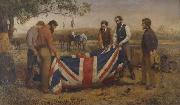Wholesale Oil Painting Reproductions No Minimum and Door to Door! |
|||||||||||
|
|
|||||||||||

|
|||||||||||
|
|
|
||||||||
All William Strutt Oil Paintings |
||||||||
|
|
||||||||
|
|
||||||||
|
Artist Introduction: English Painter, ca.1825-1915
was an English artist. Strutt was born in Teignmouth, Devon, England, and came from a family of artists, his grandfather, Joseph Strutt, was a well-known author and artist, his father, William Thomas Strutt, was a good miniature painter. William Strutt enjoyed a student life in Paris, France, and England, studying figurative and history painting. In response to a near-breakdown and problems with his eyes, Strutt decided to visit Australia, arriving 5 July 1850 on the Culloden, where he then married. In Melbourne, Strutt found employment as an illustrator on the short-lived Illustrated Australian Magazine, published by Thomas Ham, as there was little demand for the figurative and history paintings for which he was trained. Some of his designs did, however, lead to commissions, including a design for a new postage stamp, and an Anti-Transportation League card. Despite the lack of interest for major history paintings in Melbourne, Strutt continued to sketch suitable subjects, including the "Black Thursday" bushfires, which swept over the colony on 6 February 1851. It was from these sketches that Strutt composed one of his most notable paintings some 10 years later, Black Thursday, February 6th. 1851, 1864, which depicted animals and men fleeing from the fire. In February 1852, Strutt joined the growing tide of men travelling to the gold-fields surrounding Ballarat, Victoria. Despite working in the gold fields for eighteen months he found little success. He returned to Melbourne in mid-1853 and became actively involved in the city's cultural scene, undertaking a number of portrait commissions and joining the Victorian Society of Fine Arts as a founding member. William Strutt, Portrait of John Pascoe Fawkner, founder of Melbourne, 1856: oil on canvas; 61.3 x 51.2 cm. National Library of Australia.Strutt's interest in depicting the notable events of the colony was piqued by the events surrounding the Victorian Exploring Expedition led by Burke and Wills in 1860-61. He made several studies of their preparations at Royal Park, Melbourne, and followed the expedition to its first camp at Essendon, Victoria. Strutt also collected first-hand accounts from the rescue party and from John King, |
||||||||
|
|
||||||||
|
The Burial of Burke Painting ID:: 79295 |
The Burial of Burke, painting, oil on canvas, 122.0 x 204.0 cm, by William Strutt
Date 1911(1911)
cjr |
|||||||
Height Width |
INS/CM Quality |
|||||||
|
X |
| |||||||
|
|
||||||||
|
Prev Next
|
||||||||
|
|
||||||||
|
Related Paintings to William Strutt :. |
||||||||
|
|
||||||||
|
CONTACT US |

